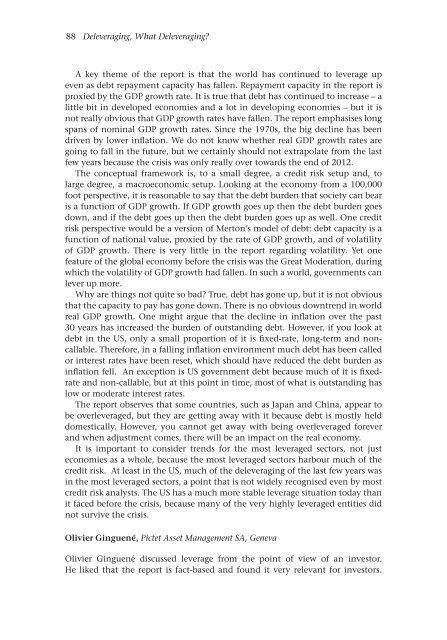1qGLG9p
1qGLG9p
1qGLG9p
You also want an ePaper? Increase the reach of your titles
YUMPU automatically turns print PDFs into web optimized ePapers that Google loves.
88 Deleveraging, What Deleveraging<br />
A key theme of the report is that the world has continued to leverage up<br />
even as debt repayment capacity has fallen. Repayment capacity in the report is<br />
proxied by the GDP growth rate. It is true that debt has continued to increase – a<br />
little bit in developed economies and a lot in developing economies – but it is<br />
not really obvious that GDP growth rates have fallen. The report emphasises long<br />
spans of nominal GDP growth rates. Since the 1970s, the big decline has been<br />
driven by lower inflation. We do not know whether real GDP growth rates are<br />
going to fall in the future, but we certainly should not extrapolate from the last<br />
few years because the crisis was only really over towards the end of 2012.<br />
The conceptual framework is, to a small degree, a credit risk setup and, to<br />
large degree, a macroeconomic setup. Looking at the economy from a 100,000<br />
foot perspective, it is reasonable to say that the debt burden that society can bear<br />
is a function of GDP growth. If GDP growth goes up then the debt burden goes<br />
down, and if the debt goes up then the debt burden goes up as well. One credit<br />
risk perspective would be a version of Merton’s model of debt: debt capacity is a<br />
function of national value, proxied by the rate of GDP growth, and of volatility<br />
of GDP growth. There is very little in the report regarding volatility. Yet one<br />
feature of the global economy before the crisis was the Great Moderation, during<br />
which the volatility of GDP growth had fallen. In such a world, governments can<br />
lever up more.<br />
Why are things not quite so bad True, debt has gone up, but it is not obvious<br />
that the capacity to pay has gone down. There is no obvious downtrend in world<br />
real GDP growth. One might argue that the decline in inflation over the past<br />
30 years has increased the burden of outstanding debt. However, if you look at<br />
debt in the US, only a small proportion of it is fixed-rate, long-term and noncallable.<br />
Therefore, in a falling inflation environment much debt has been called<br />
or interest rates have been reset, which should have reduced the debt burden as<br />
inflation fell. An exception is US government debt because much of it is fixedrate<br />
and non-callable, but at this point in time, most of what is outstanding has<br />
low or moderate interest rates.<br />
The report observes that some countries, such as Japan and China, appear to<br />
be overleveraged, but they are getting away with it because debt is mostly held<br />
domestically. However, you cannot get away with being overleveraged forever<br />
and when adjustment comes, there will be an impact on the real economy.<br />
It is important to consider trends for the most leveraged sectors, not just<br />
economies as a whole, because the most leveraged sectors harbour much of the<br />
credit risk. At least in the US, much of the deleveraging of the last few years was<br />
in the most leveraged sectors, a point that is not widely recognised even by most<br />
credit risk analysts. The US has a much more stable leverage situation today than<br />
it faced before the crisis, because many of the very highly leveraged entities did<br />
not survive the crisis.<br />
Olivier Ginguené, Pictet Asset Management SA, Geneva<br />
Olivier Ginguené discussed leverage from the point of view of an investor.<br />
He liked that the report is fact-based and found it very relevant for investors.


